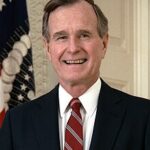The Historic NAFTA Negotiation Framework
President George H.W. Bush completed the groundbreaking NAFTA negotiation in 1992. This agreement eliminated most trade barriers between the United States, Canada, and Mexico. Bush’s vision created the world’s largest free trade zone at that time. 📊 The deal covered a market of 360 million consumers worth $6 trillion in combined GDP.
Strategic Economic Integration
Bush built upon the existing U.S.-Canada Free Trade Agreement from 1988. He expanded negotiations to include Mexico in 1990. The NAFTA negotiation aimed to boost American competitiveness globally. Bush believed free trade would create jobs and increase economic growth. 💰 The agreement promised to eliminate tariffs on thousands of products over 15 years.
Diplomatic Achievement
The NAFTA negotiation required complex multilateral diplomacy. Bush worked closely with Canadian Prime Minister Brian Mulroney and Mexican President Carlos Salinas. The talks addressed sensitive issues like labor standards and environmental protection. ⚠️ Critics worried about job losses in manufacturing sectors. Bush argued the benefits would outweigh short-term disruptions.
Impact:
Immediate Economic Transformation
Bush’s NAFTA negotiation framework took effect under President Clinton in 1994. Trade between the three nations increased dramatically within the first decade. 📈 U.S. exports to Mexico grew from $41 billion in 1993 to $164 billion by 2008. American businesses gained access to cheaper labor and expanded markets. Consumer prices dropped on many imported goods.
Long-term Regional Integration
The agreement fundamentally changed North American commerce patterns. Manufacturing shifted toward Mexico, particularly in automotive and textile industries. 🌍 Supply chains became deeply integrated across borders. The deal strengthened political relationships between the three nations. Economic interdependence reduced the likelihood of regional conflicts significantly.
Historical Legacy and Lessons
Bush’s NAFTA negotiation became a model for future trade agreements worldwide. The deal demonstrated how trade liberalization could benefit developed and developing nations. 🔥 However, it also sparked ongoing debates about globalization’s effects on workers. Many economists credit NAFTA with helping Mexico modernize its economy. The agreement remains one of Bush’s most significant diplomatic achievements, influencing trade policy for decades.
